 July
July
Basic Accessories for Musical Instruments
Prices are approximate, from Christmas 2017
I showed the drummers how to do a Grand Paw Roll. It's like a Grand Flam but smoother. There, I just played it for you! Did you like it?
(Kids: buy my whole calendar! $7 at the Family Music Center, 4110 SW 9th, Des Moines Iowa!)
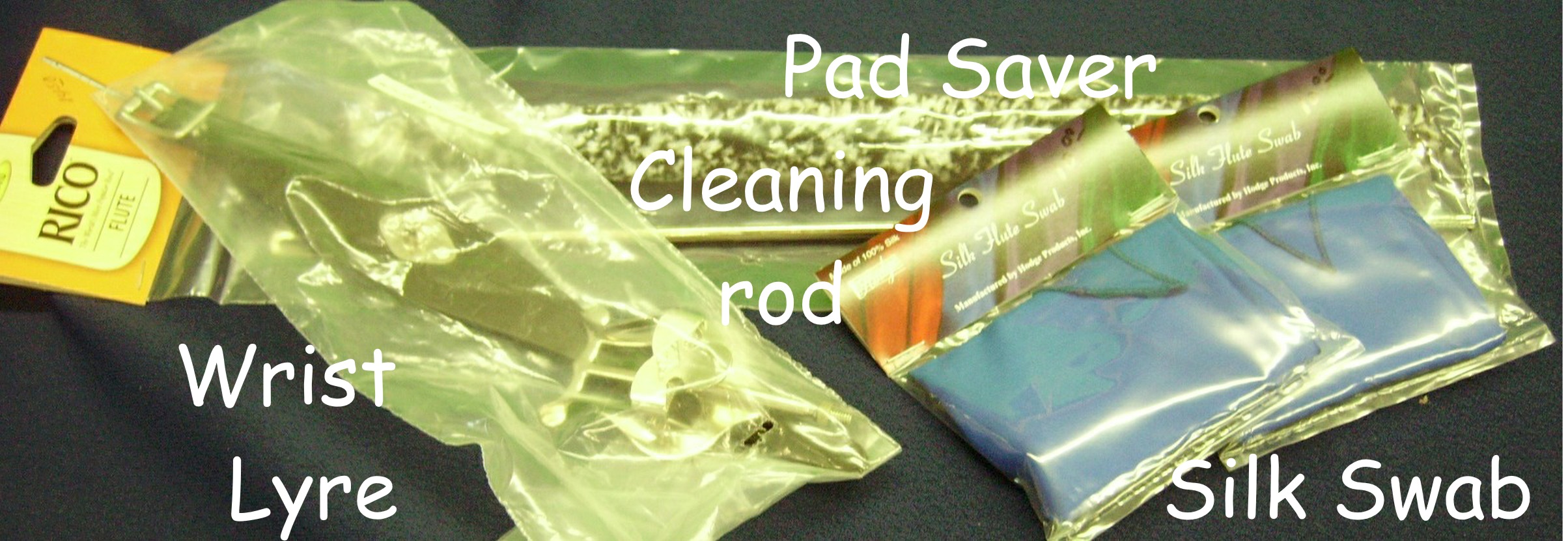
Flute accessories:
Silk Swabs $10.00 (After you finish playing, pull a swab through the flute to dry it. You can use any rag through the hole in your flute cleaning rod that comes with your flute, but the silk swab is very absorbant.)
Cleaning Rod $3.95 (These metal rods are usually provided with your flute. Dry your flute after you play by putting cloth through the hole and pushing it through the flute. Use enough cloth that it will push firmly against the walls of the flute. Use a long enough strip so that when you put it in your "head joint" - the section of the flute that you blow into - you can tug on the ends of the cloth to pull it out if it gets stuck.) Cleaning rods have a line cut all the way around, about an inch from the end without the hole. This hole is to check the adjustment of the cork inside the head joint. Put the rod in the head joint all the way, and see if that line is in the very middle of the hole you blow into. If it isn't, the cork has been moved. It is adjusted with the end cap of the head joint. Tighten the end cap to move the cork farther from the hole; to move it closer, unscrew the end cap and push it in. If it moves too easily the cork leaks and needs to be replaced. To check it, suck on the end of the head joint with your thumb over the blow hole and see if it holds a vacuum.
Pad Saver $14.50 (after you "swab" your flute, store this inside the flute to keep it eveb drier. DON'T use this without swabbing first; that will only hold the moisture against the pads and wear them out faster.)
Wrist Lyre $26.00 (straps to your wrist)(a "lyre" holds shall music sheets so you can play while marching.)
Forearm Lyre $15.95(not shown)the wide base straps to your forearm)
Mouthpiece cleanser spray $4.95, Roche-Thomas brand, for "sanitizing"
Metronome $13.95 for Quik Time to $34.95 for Matrix MR-500. This keeps time, like a drum section except a simple beat, at any speed from 40 beats per minute to 208 beats per minute. The Matrix is easier to set than cheaper metronomes and many more expensive metronomes because it has a large dial which you can quickly set to any speed. Mechanical (non- electric) metronomies used to always be that easy, but now they are a lot more expensive.
Here is a 4-minute video about cleaning the inside and polishing the outside of your flute, putting it together and taking it apart:
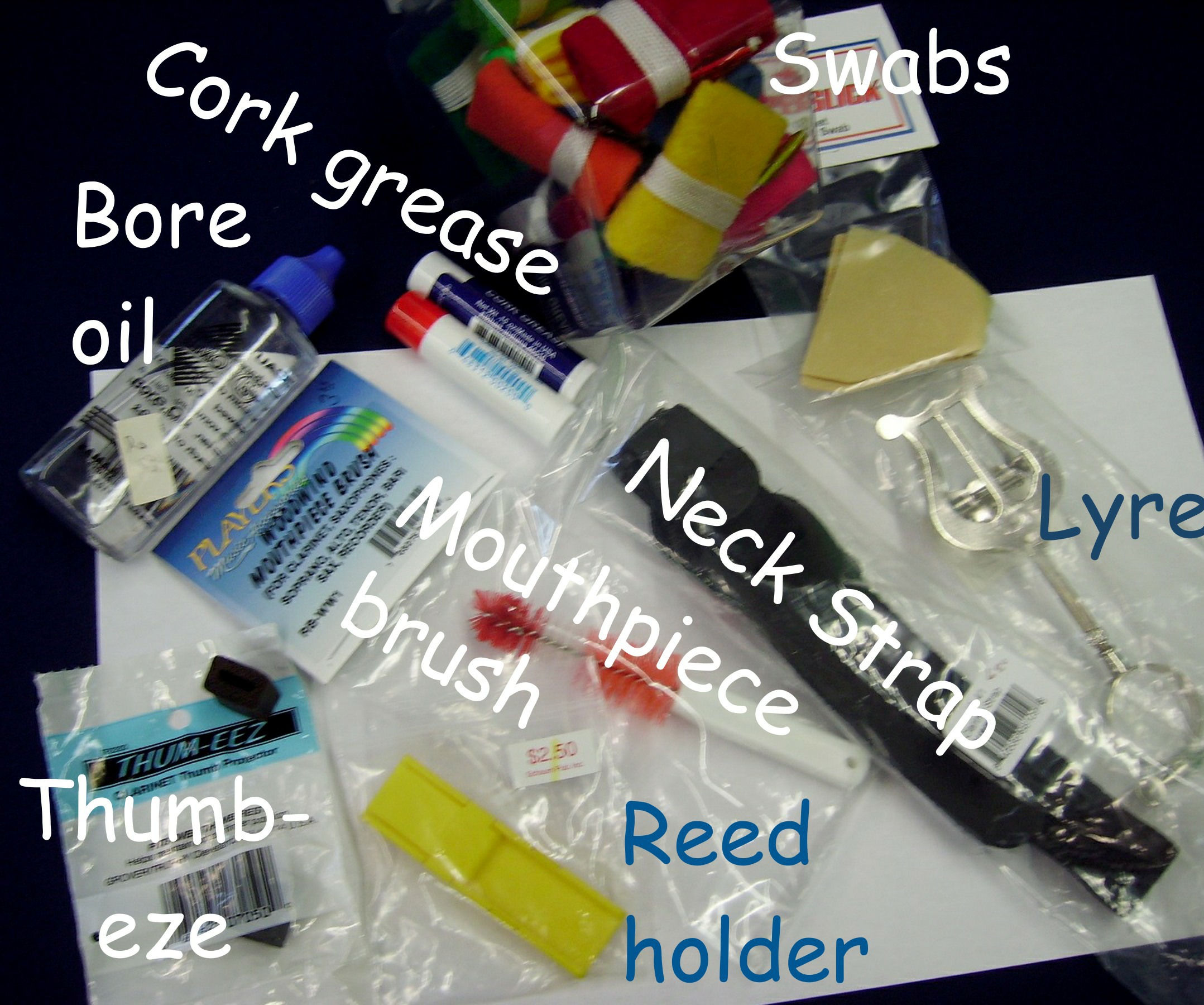
Clarinet accessories:
Cork grease $2.50 (when your "cork joints" - that hold the sections of your clarinet together - get so dry that it is hard to push the sections [joints] together or take them apart, rub this grease on the corks. Although the lipstick-type container makes it easy to apply, when you apply it and then push the joints together, there will be excess grease which you may want to wipe off with a tissue.)Swabs $3.95 for colored felt, $4.50 for chamois, $16.00 for silk, Hodge brand. $12.70 for Jewell brand. Available in different colors. After you have finished playing for the day, pull this swab through your instrument to absorb all the moisture inside your instrument so it doesn't rot your pads and make you instrument smell bad. (Let's call that "moisture" what it is: spit.)
Thumb Eze $1.50 This is a loop of soft rubber that fits on the "thumb rest" on the "lower joint" (the lowest section of your clarinet that has keys). This makes the thumb rest softer, to make life easier for your thumb.
Mouthpiece Brush $3.15. Use with soap and water. Or mouthpiece cleaning paper, $3.65 Selmer, which you pull through the mouthpiece to dry it after you play.
Reed Holder $2.50 You will probably want to take your reed off your mouthpiece when you put your instrument away, so you can swab out the inside of your mouthpiece. You can store your reed in this plastic case. When you buy reeds, some come in reed holders, but some of them are harder to get the reed in and out of without chipping the reed. This makes it very easy. Another feature of this holder is that it "irons" the reed; it keeps the reed very flat so it doesn't wrinkle. If your reed is a little wrinkled when you put it on it will take just a little bit of playing before it straightens out again and plays at its best.
Lyre $7.95 (a "lyre" holds shall music sheets so you can play while marching. If you have several sheets of music, you may need to also buy a "flip folder", not shown. You put the sheets in the plastic sleeves of the flip folder, and put the flip folder in the lyre.)
Bore oil $2.95 If your clarinet is made of wood, (a very hard wood called "grenadilla"), it needs
Neck Strap $6.00.
Pad cleaning paper, $10.99 Yamaha. Close each pad with the paper under it 3 times to remove moisture directly from the pad and tone hole, which swabs can't reach. Close each pad on a different section of the paper. This will not only remove moisture (let's call it what it is: spit) but the food particles in spit which make pads sometimes stick to the tone holes.
Mouthpiece cleanser spray $4.95 Roche-Thomas brand, for "sanitizing"
Metronome $13.95 for Quik Time to $34.95 for Matrix MR-500. This keeps time, like a drum section except a simple beat, at any speed from 40 beats per minute to 208 beats per minute. The Matrix is easier to set than cheaper metronomes and many more expensive metronomes because it has a large dial which you can quickly set to any speed. Mechanical (non- electric) metronomies used to always be that easy, but now they are a lot more expensive.
Here is a 9-minute video I recommend that explains very clearly the best way to clean your clarinet\ after you play it, the best way to put it together and take apart, the best way to line up your reed, and the importance of using a "reed guard" to store reeds after you use them: to "keep them flat".
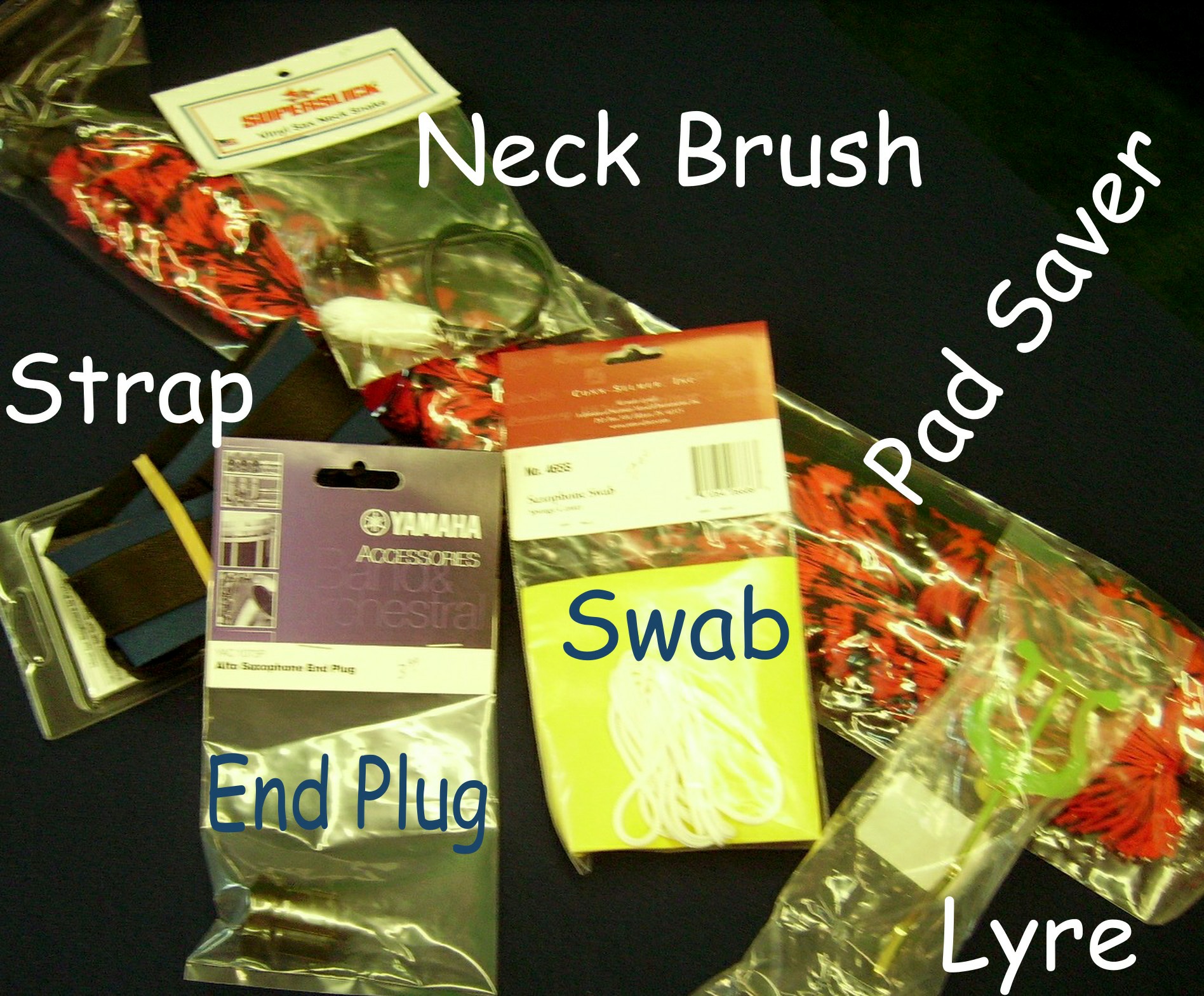
Saxophone accessories:
Neck Strap $20.95 for Neotech, $15.00 for Superslick. Unpadded straps are less than $10.00
Swab $18.00 for silk, Hodge brand; $4.20 for felt Superslick brand. After you have finished playing for the day, pull this swab through your instrument to absorb all the moisture inside your instrument so it doesn't rot your pads and make you instrument smell bad. (Let's call that "moisture" what it is: spit.)
Neck "snake" $3.75. This is a flexible shaft with a coarse brush on one end and a soft brush on the other. Push the coarse brush first through the neck and pull it through so that the soft brush comes out last. The first brush removes slime, and the second removes "moisture".
Pad Saver $25.25 After you "swab" your sax, store this inside the sax to keep it even drier. DON'T use this without swabbing first; that will only hold the moisture against the pads and wear them out faster.
Lyre $5.25 (a "lyre" holds shall music sheets so you can play while marching.)
End Plug $3.99 Insert this round plastic into the top of your sax after you take off the "neck" to store the sax in your case. This helps hold the sax firmly in the case so it doesn't jiggle around. It especially protects the octave key on a sax where the octave key mechanism extends beyond the end of the sax, and in a case especially designed to hold the sax in place by gripping the end plug. In cases so form fitted that the sax doesn't move at all with the lid closed, the ned plug has little purpose. Pad savers have small end plugs built into them, which often fall off with much use.
Reed Holder $2.50 You will probably want to take your reed off your mouthpiece when you put your instrument away, so you can swab out the inside of your mouthpiece. You can store your reed in this plastic case. When you buy reeds, some come in reed holders, but some of them are harder to get the reed in and out of without chipping the reed. This makes it very easy. Another feature of this holder is that it "irons" the reed; it keeps the reed very flat so it doesn't wrinkle. If your reed is a little wrinkled when you put it on it will take just a little bit of playing before it straightens out again and plays at its best.
Mouthpiece cleanser spray $4.95 Roche-Thomas brand, for "sanitizing"
Cork grease $2.50 (when your "cork joints" - that hold the sections of your clarinet together - get so dry that it is hard to push the sections [joints] together or take them apart, rub this grease on the corks. Although the lipstick-type container makes it easy to apply, when you apply it and then push the joints together, there will be excess grease which you may want to wipe off with a tissue.)
Metronome $13.95 for Quik Time to $34.95 for Matrix MR-500. This keeps time, like a drum section except a simple beat, at any speed from 40 beats per minute to 208 beats per minute. The Matrix is easier to set than cheaper metronomes and many more expensive metronomes because it has a large dial which you can quickly set to any speed. Mechanical (non- electric) metronomies used to always be that easy, but now they are a lot more expensive.
Here is a 3-1/2 minute video about swabbing out your saxophone after you play, storing your reed in a reed holder, putting your sax together, etc:

Trumpet accessories:
Valve Oil $6.55 for 2 ounces. Put 4-6 drops on each valve each day as you begin to play.
Slide Grease $2.45 Apply a bit of grease to the tuning slide and to the three valve slides when they become difficult to pull out. The video below recommends once a week! The average trumpet probably gets it once a year, but once a week would certainly keep them moving freely!
Lyre $5.00 or $16.95 (a "lyre" holds shall music sheets so you can play while marching.)
"Snake" $6.65 This is a flexible long brush that will go around the curve in the tuning slide, and in the curve at the back of the bell, to clean it out.
Valve brush $1.50 This is a larger diameter brush that will clean out the valve "casings" (the tubes in your trumpet that the valves go up and down in) while your valves are out of the trumpet.
Mouthpiece brush $2.95 Once a week, clean out your trumpet mouthpiece with this, with warm water and a little soap. It might not reach all the way through the very smallest diameter of the mouthpiece; you might need a cue tip for that.
Practice mute $39.95, Windy City brand. You need this if you want to practice in an apartment where you can hear your neighbors, or in a house when your family is asleep or doing something that will be disturbed by loud music. A more expensive Windy City model is $59.95. Denis Wick has one for $70.99, and Yamaha has one with a microphone that feeds headphones so you can blast out your own ears without bothering anyone else, for $229.99.
Straight mute $18.99 to $120.99. This makes the trumpet a little quieter, but the main feature of it is that it gives the trumpet a different tone. School band parts often require a straight mute. "Denis Wick" has a mute made of fiber for 18.99 and a wood one for $120.99. Aluminum straight mutes: Bach $36.00, Tom Crown $67.00 or $72.00 with a copper end, Windy City $49.95.
Cup mute $24.99 for Denis Wick fiber mute. For $59.95, Windy City has a 3-in-one mute. A cup mute with a snap-off cup which leaves it a straight mute, or you can use just the cup for a plunger mute. This gives the trumpet a very pretty mellow tone, and is required in some band parts, though not as often as a straight mute. In jazz bands, it is more common than a straight mute.
Mouthpiece case $6.95 this is what you need if your case doesn't have a special place to hold your mouthpiece securely. It keeps the mouthpiece from banging around and denting the trumpet.
$4.95 Mouthpiece cleanser spray, Roche-Thomas brand, for "sanitizing" your mouthpiece.
Metronome $13.95 for Quik Time to $34.95 for Matrix MR-500. This keeps time, like a drum section except a simple beat, at any speed from 40 beats per minute to 208 beats per minute. The Matrix is easier to set than cheaper metronomes and many more expensive metronomes because it has a large dial which you can quickly set to any speed. Mechanical (non- electric) metronomies used to always be that easy, but now they are a lot more expensive.
Below is a 12-minute video about how to oil your valves every day, grease your slides every week,and wash the inside of your trumpet every month:
Caution about oiling valves
The Conn-Selmer video above should have explained two dangers of having young children pull valves out part way to oil them:
First, they might pull them out all the way and drop them on the floor! Not only could this damage the valve, but it will put dirt on it, so it won't go up and down until you take it to a repair shop.
Second, if they take all the valves out at the same time, they might not put the valves back in the correct valve "casing" (the tube in the trumpet that the valves move up and down in). In the wrong order, the trumpet won't play.
The third danger was addressed by the video above: that the valve "guide" might not go into its slot in the valve "casing" of the trumpet. (The "guide" is the little square knob that slides up and down on the valve when it is played, but that is held down by a spring when the valve is out of the trumpet. The "casing" is the name of the tube on the trumpet that the slide moves up and down in. It has a slot that fits the guide.) The video does a good job of explaining how face the valve the correct way, and to listen for the "click" when the guide snaps into its slot.
One thing not explained is that most modern trumpets have two slots in the valve casing for each valve, so that you can hear that "click" and find out the valve is exactly backwards. Besides that, most modern guides are made of plastic which wear down, requiring special care to determine if the valve is back in correctly. Many older guides were made of metal, fitting into only one slot, making this step easier.
Perhaps it is this "complication" which caused another video about valve oiling produced by a school that trains people to repair band instruments: BIR Southeast Tech, to say young children might find that way of oiling valves "too complicated". So they suggested taking out each valve slide and dropping oil in it.
The problem with that solution is that on many trumpets, even new ones, pulling all three slides on the trumpet will be harder for young children than pulling out the valves part way! A few new trumpets are made with slides loose enough to pull out easily if kept well lubricated - a big "if" - but most older trumpets are made with tighter slides. Also, taking the slides out every day risks getting dust or lint on them, depending on where you lay them, making them harder to remove the next time.
The BIR video says oiling from the bottom is wrong because then the oil is "hard pressed" to get to the top of the valves. Well, sure, if you just put in oil and immediately turn the trumpet right side up and start playing. But if while the trumpet is upside down, you work the valves a bit, and THEN turn the trumpet right-side up and work the valves again, the oil has an opportunity to go through the middle of the valves, (which are hollow, with a hole at both ends), and get to the top of the valves. Then when you turn the trumpet right side up the oil starts at the top and works its way around the sides to the bottom.
The BIR video says it is not necessary to "spin" the valve after you oil it. They mean, to twist the valve back and forth. Actually a little "twist" DOES help distribute the oil, but no more than a quarter turn is helpful. The video's reason not to "spin" the valve, presumably, is the hope that will make the valve guide go into its slot when you put the valve back in; but even if you try not to "spin" it, it will probably not go straight back in the slot without doing a little twisting to make sure it is in. If it is not in, and you twist it to get it in, you will know it is in when you hear a little click and when the valve won't twist any more.
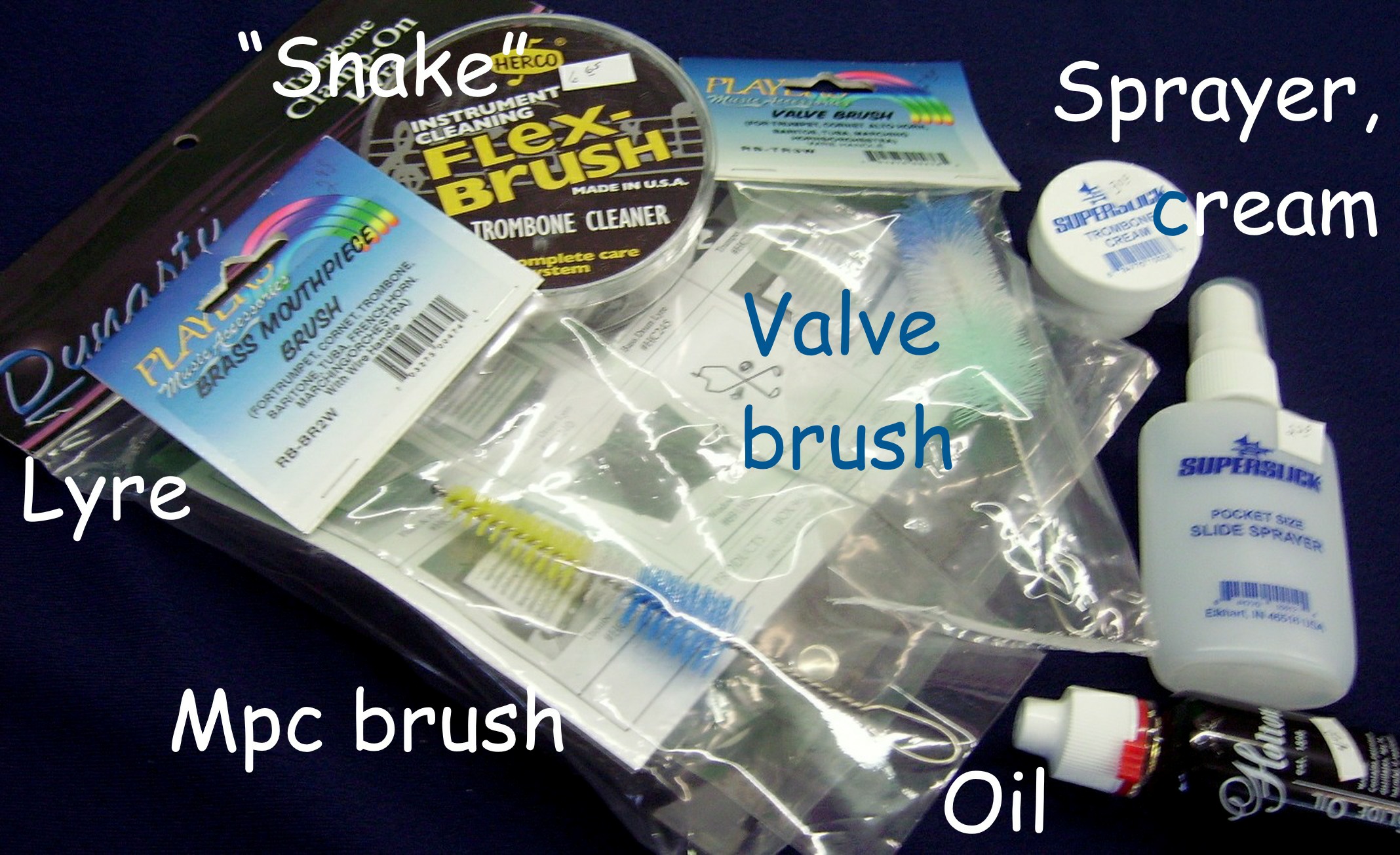
Trombone accessories:
Oil $4.00 Beginners normally lubricate their slides with a few drops of oil each time they play. It is the simplest way to lubricate slides. It doesn't work as well as cream on a good, undamaged slide. However, if there are many dents in your slide, hopefully that have been brought under control by a repairman, oil might better reduce the scratchiness.
Cream $3.00 Many professional trombonists use Pond's unscented cold cream. Specially packaged trombone cream fits in your case easier. Put a dab on your inside slide, use your finger to spread it the whole length of the slide on both sides and at the same time to wipe as much excess cream from the slide as the finger can. This puts just the right amount of cream on the slide. Then spray water on it and put the slide together. Then when the slide gets scratchy or dry again, just spray water on it again, until that no longer works well; then you have to completely clean the old cream off and start over fresh. About once a week you will need to completely clean it.
Sprayer $2.25 Anything that puts a fine mist of water on the slide will work; what is marketed as a trombone sprayer is simply a spray bottle that fits easily in your case. Water not provided. Although there is an additive marketed to make the water wetter.
"Snake" $6.65 This is a flexible long brush that will go around the curve in the tuning slide, the curve at the end of the slide (called the "boot"), and through both the inside and outside slide, to clean it out.
Cleaning Rod. $4.95. This is for cleaning your outside slide. It won't fit through your inside slide. Put cloth through the hole and push it down to the end of the slide. Use enough cloth that it will push firmly against the walls of the slide. If you are cleaning your "outside slide" with too much cloth on your cleaning rod, it could get stuck when you try to pull it back out! If that happens, all you have to do is push the cleaning rod and cloth back down in the slide, and then twist the cleaning rod as you pull it back out. That will cause the cloth to compress again to a smaller diameter so it can come back out. If it jams again before you get it out, simply repeat: simply push down again a bit, and twist more as you pull back out. Using enough cloth so you need to do that, to get the cleaning rod back out, is actually the best way to get the maximum cleaning out of your cloth.
Mouthpiece Brush $2.45 $2.95 Once a week, clean out your mouthpiece with this, with warm water and a little soap. It might not reach all the way through the very smallest diameter of the mouthpiece; you might need a cue tip for that.
Valve Brush $2.10 This is for trombones with valves instead of a slide; it is also for baritones. It is a larger diameter brush that will clean out the valve "casings" (the tubes in your trombone that the valves go up and down in) while your valves are out of the trombone.
Lyre $16.95 This lyre clips to your trombone bell. An older, cheaper style clips to the mouthpiece "receiver" tube. A "lyre" holds shall music sheets so you can play while marching.
Straight Mute $41.00 Bach
Cup Mute $52.00 Bach
Practice Mute $55.00, Mutec brand. You need this if you want to practice in an apartment where you can hear your neighbors, or in a house when your family is asleep or doing something that will be disturbed by loud music. Yamaha has one with a microphone that feeds headphones so you can blast out your own ears without bothering anyone else, for $229.99.
Straight mute $18.99 on up. This makes the trombone a little quieter, but the main feature of it is that it gives the trombone a different tone. More nasal. Shrill. School band parts often require a straight mute.
Cup mute $24.99 for Denis Wick fiber mute. This gives the trombone a very pretty mellow tone, and is required in some band parts, though not as often as a straight mute. In jazz bands, it is more common than a straight mute.
Mouthpiece cleanser spray $4.95, Roche-Thomas brand, for "sanitizing"
Metronome $13.95 for Quik Time to $34.95 for Matrix MR-500. This keeps time, like a drum section except a simple beat, at any speed from 40 beats per minute to 208 beats per minute. The Matrix is easier to set than cheaper metronomes and many more expensive metronomes because it has a large dial which you can quickly set to any speed. Mechanical (non- electric) metronomies used to always be that easy, but now they are a lot more expensive.
Below is a 10-minute video about cleaning and oiling your trombone. There is one detail they leave out which if you don't know could lead to frightening consequences: At the 7 minute mark, they acknowledge that if you are cleaning your "outside slide" with too much cloth on your cleaning rod, it could get stuck when you try to pull it back out! But it doesn't tell you what to do if that happens! Creepy!
Well, if that happens, all you have to do is push the cleaning rod and cloth back down in the slide, and then twist the cleaning rod as you pull it back out. That will cause the cloth to compress again to a smaller diameter so it can come back out. If it jams again before you get it out, simply repeat: simply push down again a bit, and twist as you pull back out.
Using enough cloth so you need to do that, to get the cleaning rod back out, is actually the best way to get the maximum cleaning out of your cloth.
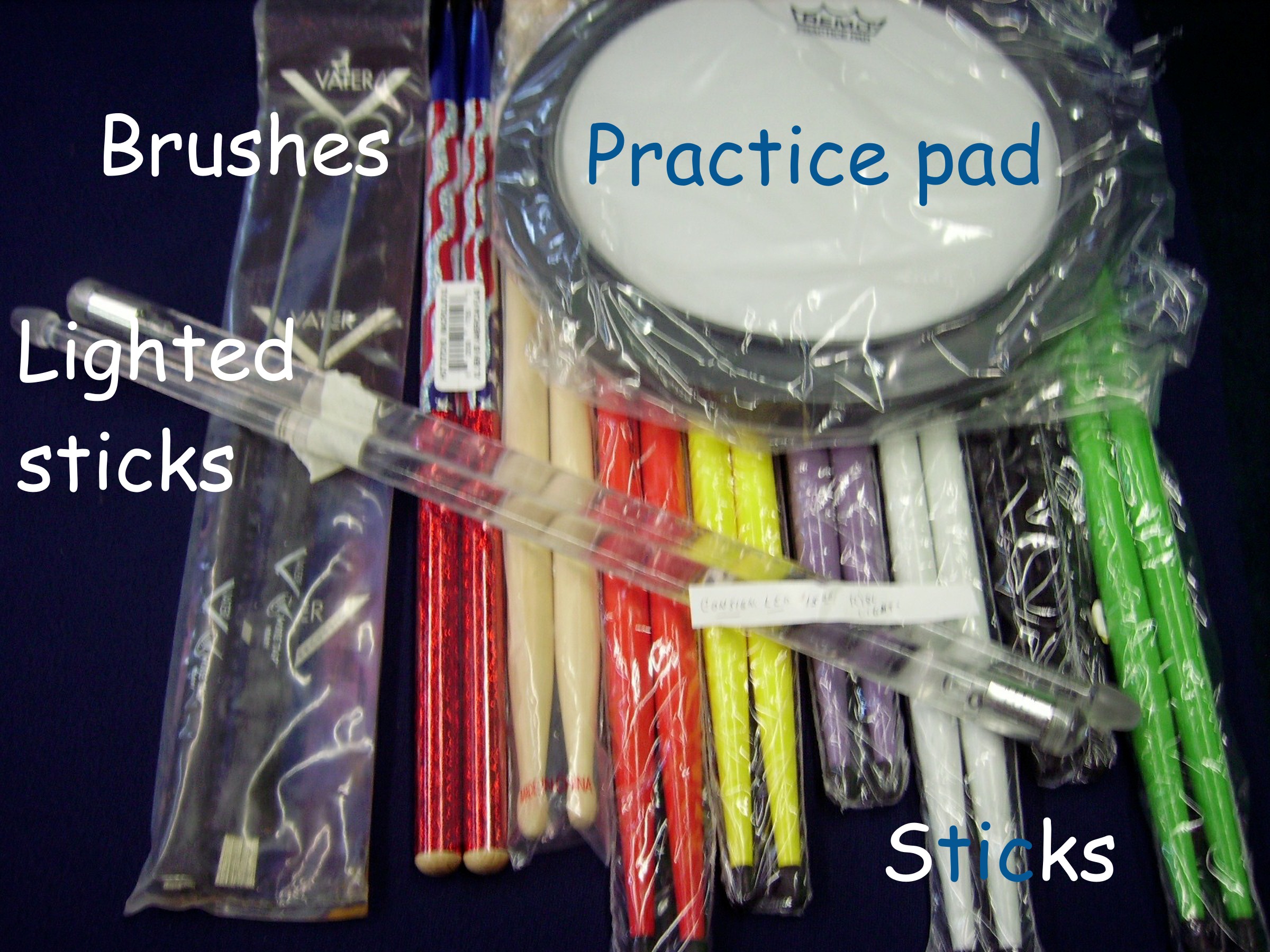
Drum accessories:
Drum accessories:Sticks $5 to $25
Practice Pad $35.99 The sticks bounce on this drum head just like on a drum, but as quietly as a loud whisper. It is for when you need to practice without disturbing others. It is also much cheaper than a real drum, so sometimes people learn with it before they buy a drum.
Drum Key $4.05 this is to tighten or loosen the "lugs" - the screws that hold down the drum head. The "heads" of these "screws" do not have a hex head like a bolt, but a square head, requiring a "female" square hole in an adjusting tool.
Brushes $37.30 Vater brand - metal. Brushes have handles so they can be held like drum sticks. Out of the handles, and often retractable, are long wires so that instead of hitting a drum with a single cylinder of wood, you hit it with a few dozen strands of fine wire. It gives a quieter, mushier sound, very useful in quiet tasteful jazz.
Metronome $13.95 for Quik Time to $34.95 for Matrix MR-500. This keeps time, like a drum section except a simple beat, at any speed from 40 beats per minute to 208 beats per minute. The Matrix is easier to set than cheaper metronomes and many more expensive metronomes because it has a large dial which you can quickly set to any speed. Mechanical (non- electric) metronomies used to always be that easy, but now they are a lot more expensive.

Violin, Viola, Cello, Bass accessories:
Rosin $2.80 in wood case, Kafko brand, $13.65 wrapped in green fabric, Hill brand. Spray rosin is available if you have lots of bows to rosin; you spray it to get it started quickly and then finish with regular rosin. Rosin is what makes the hair, dragging across the strings, grip the strings so they produce sound. With no rosin on a bow there is no sound. Whenever the sound grows faint or mushy, or a certain part of the bow becomes "silent", rub on more rosin. Hold the rosin in your fingers, place the bow with your other hand over the rosin, hold the thumb of your rosin-holding hand on top of the bow to press the bow hair against the rosin, and move the bow several times back and forth until you feel a drag.
Mute $1.35 rubber, shaped like violin; $6.95 for ebony. Clips on top of bridge. These are not mutes to silence the violin but to give it a darker tone. Practice mutes, to make the violin very quiet, are $6.
Tuner, electronic $12.95 to $40 This clips to one of the pegs. It senses the vibrations coming through the wood, not the sound coming through the air, so it works even with other instruments playing around you. It tells you whether your string is too high or too low or just right. If your string is a note or more too low or too high, it will tell you the letter of the note that it is playing, and you will need to figure out from that how much higher or lower to go. It will not tell you whether the note that your string is playing is higher or lower than the note your string should be playing. Your ears will need to tell you that.
Tuner, acoustic $5.25 this has 4 cylinders, one for each string, that have a reed like a metal harmonica reed inside them. You blow the reed gently, and it plays the note that you want to tune your string to. Your ear needs to tell you whether to tighten the peg to raise the pitch, or loosen to lower.
Violin Shoulder Rest $19,50 Resonans brand, $20.50 Everest, $52.50 Kun, $58.00 Wolf. To save money, beginners usually start with just a sponge held to their violin with a rubber band. A shoulder rest raises the violin higher than a sponge so your neck doesn't have to stoop down to reach the top of the violin. It allows your chin to hold the violin so securely that your hand is not necessary to hold the violin, which is important when you start to learn vibrato.
Peg dope $13.99 If your pegs slip, you may want to take your violin to a repairman. If you want to fix the problem yourself, you may want to try peg dope. It is a liquid, or something like a crayola or lipstick, that you rub on the part of your pegs that contact the wood of your peg box. (You have to take the string off and take the peg out of the violin or viola or cello.) An alternative substance is what repairmen used before peg dope was marketed: chalk and soap. If the peg is so tight that it grabs and won't hardly move and almost seems like making it turn might break it, rub soap on it. If the peg slips before the string reaches the correct pitch, rub chalk on it.
Metronome $13.95 for Quik Time to $34.95 for Matrix MR-500. This keeps time, like a drum section except a simple beat, at any speed from 40 beats per minute to 208 beats per minute. The Matrix is easier to set than cheaper metronomes and many more expensive metronomes because it has a large dial which you can quickly set to any speed. Mechanical (non- electric) metronomies used to always be that easy, but now they are a lot more expensive.

Guitar accessories:
Picks $0.50 on up. There are about 3,578 different kinds of picks. (Actually I just made up that number.)
Strap $8 to $30, roughly. Many different styles and images.
Tuner, electronic $12.95 to $40 This clips to the head stock - the top end of the guitar. It senses the vibrations coming through the wood, not the sound coming through the air, so it works even with other instruments playing around you. It tells you whether your string is too high or too low or just right. If your string is a note or more too low or too high, it will tell you the letter of the note that it is playing, and you will need to figure out from that how much higher or lower to go. It will not tell you whether the note that your string is playing is higher or lower than the note your string should be playing. Your ears will need to tell you that.
Tuner, acoustic $5.25 this has 6 cylinders, one for each string, that have a reed like a metal harmonica reed inside them. You blow the reed gently, and it plays the note that you want to tune your string to. Your ear needs to tell you whether to tighten the peg to raise the pitch, or loosen to lower.
Pickup $15-$300 roughly.
Cord $19.99 for 10', $29.99 for 20', Fender brand. (Guitar cord to connect guitar to amplifier.)
Polish $6.00, spray, SIT brand.
Strings $6.00 to $15.00 per set, various kinds and brands.
Metronome $13.95 for Quik Time to $34.95 for Matrix MR-500. This keeps time, like a drum section except a simple beat, at any speed from 40 beats per minute to 208 beats per minute. The Matrix is easier to set than cheaper metronomes and many more expensive metronomes because it has a large dial which you can quickly set to any speed. Mechanical (non- electric) metronomies used to always be that easy, but now they are a lot more expensive.
